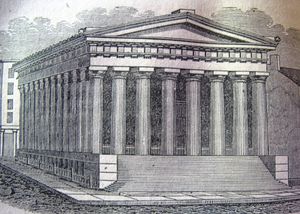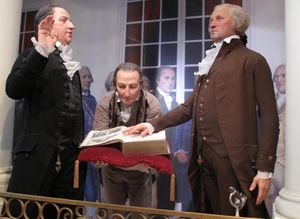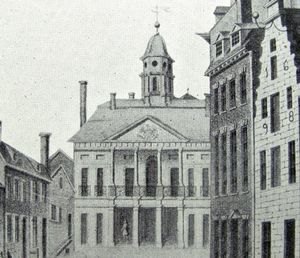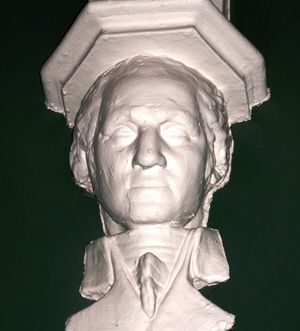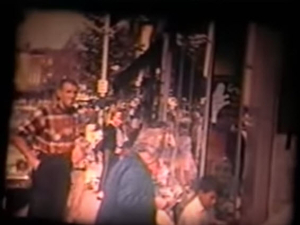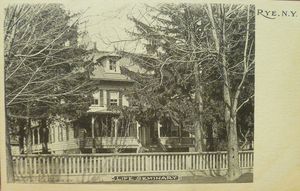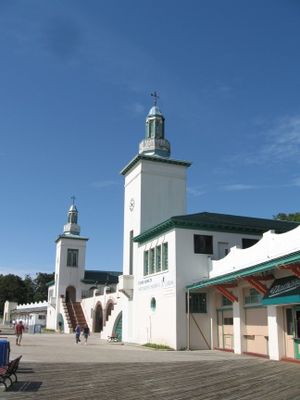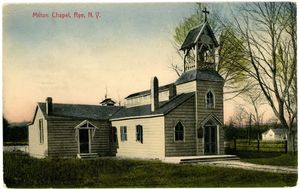Six Degrees of George Washington and Rye History
Suzanne Clary, president of the Jay Heritage Center, is a MyRye.com history correspondent. Today our history teacher wishes us a happy and healthy Washington's Birthday and tells us about the six degrees of George Washington.
Many of Rye’s residents commute to downtown Manhattan, and no doubt pass the ubiquitous statue of George Washington at 26 Wall Street swarmed by IPhone snapping tourists.
But what about the history of the building behind George and the site itself? What we see today, New York’s first Customs House, was built between 1833 and 1842. The Doric columned edifice is Greek Revival in style, deliberately modeled on the ancient Parthenon. It was designed by a young Alexander Jackson Davis and his older partner and mentor, Ithiel Town.
Like hundreds of other pediment topped monuments that went up throughout the Empire State in the mid 19th Century, the New York Customs House was an homage to the ideals of Greek democracy that we admired as a young government and adapted for our own use.
(PHOTO: New York Custom House designed by AJ Davis (1833) Greek Revival style. This engraving shows the building before the addition of Ward's statue of George Washington in 1883.)
On the steps of this “temple” is the iconic statue of Washington by John Quincy Ward Adams that garners the most daily fanfare; although it has been inextricably cemented into our consciousness like the toy that goes with a Happy Meal, it was not an original part of the Town & Davis concept. Rather Ward, who was one of the first American sculptors to produce works in bronze, was commissioned many years later to create the over-sized, heroic portrait of our first president. The occasion? Commemorating the 1883 centennial of the end of the American Revolution and the evacuation of the British from New York.
The statue was erected on roughly the same site where Washington took the oath of office as our first President on April 30, 1789 surrounded by his closest advisors including Rye’s John Jay. No longer under Dutch or English domain, New York City had its first truly American mayor, James Duane, who officiated on this momentous day.
(PHOTO: In this diorama from historic Mount Vernon, New York’s Mayor James Duane swears in President George Washington at Federal Hall while John Jay looks on like Woody Allen in Zelig (rear center).)
But the location of Washington’s statue and the Custom House call to mind even more seminal moments in US history. It was on this hallowed ground that another historic building stood from 1700 to 1812 – it was Manhattan’s City Hall, which was then renamed Federal Hall, home to our first US Capitol – home of the first Congress, the first Supreme Court, and the first Executive Branch offices of our nation. This is where the first Bill of Rights to our new constitution was adopted on September 25, 1789.
Federal Hall was ultimately razed in 1812 but the events it witnessed could not be erased.
(PHOTO: New York's Federal Hall (1700) The balcony on which George Washington was sworn in is visible here; a piece of the original railing is preserved at the Federal Hall National Memorial.)
The Customs House built over the footprint of Federal Hall soon became too small for its original purpose, though it was utilized for some years by the US Treasury to store tons of gold and silver. In 1939, its adaptive value as a portal to our early revolutionary beginnings was recognized and it was added to the National Register of Historic Places. In 1955 it was further enshrined and protected as a National Memorial. Today it is owned and operated by the National Park Service and includes a museum dedicated to preserving the artifacts and stories of our young country, the tangible and intangible touchstones of our American heritage.
Coincidentally, to celebrate President’s Day, you can take a look at a much rarer sculpture of George Washington inside another A. J. Davis landmark closer to home – Whitby Castle. Ten years after the NY Customs House was completed to rave reviews, Davis designed this Gothic Revival masterpiece in 1852 for stockbroker William Chapman who no doubt while commuting between Rye and Wall Street, frequently retraced Washington’s footsteps himself.
As you enter the front hall of Whitby, now the Rye Golf Club, look up at the ceiling and see if you can spot George for yourself. Happy Washington's Birthday!
(PHOTO: Bust of George Washington in entry hal.)
(PHOTO: Whitby Castle, Rye designed by AJ Davis (1852) Gothic Revival style. This engraving shows Whitby before golf carts.)


